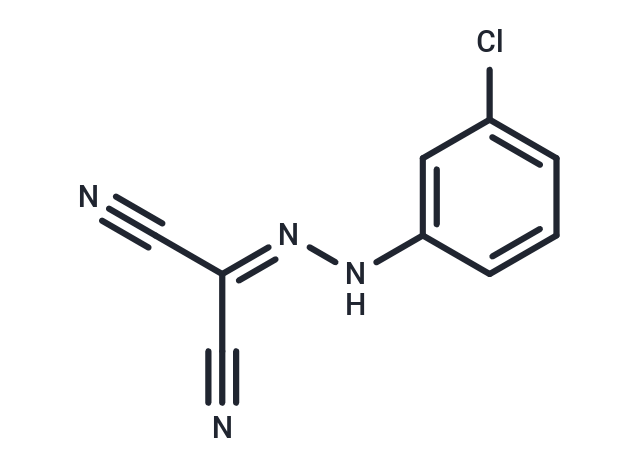Shopping Cart
- Remove All
 Your shopping cart is currently empty
Your shopping cart is currently empty

CCCP (Carbonyl Cyanide m-Chlorophenylhydrazone) is an oxidative phosphorylation (OXPHOS) inhibitor and mitochondrial proton carrier uncoupler. CCCP inhibits the activation of STING and its downstream signaling molecules TBK1 and IRF3.

| Pack Size | Price | Availability | Quantity |
|---|---|---|---|
| 100 mg | $41 | In Stock | |
| 200 mg | $58 | In Stock | |
| 500 mg | $97 | In Stock | |
| 1 mL x 10 mM (in DMSO) | $45 | In Stock |
| Description | CCCP (Carbonyl Cyanide m-Chlorophenylhydrazone) is an oxidative phosphorylation (OXPHOS) inhibitor and mitochondrial proton carrier uncoupler. CCCP inhibits the activation of STING and its downstream signaling molecules TBK1 and IRF3. |
| In vitro | METHODS: Human cervical cancer cells HeLa were treated with CCCP (20 μM) for 30 min, and the effect on the mitochondria-labeled fluorescent dye DiOC6 was observed using live cell fluorescence microscopy. RESULTS: CCCP-induced loss of mitochondrial membrane potential resulted in efflux of DiOC6 from mitochondria into the cytoplasm and subsequent localization to punctate structures. [1] METHODS: Mouse alveolar epithelial cells, MLE-12, were treated with CCCP (10-50 μM) for 2-18 h. The expression levels of the target proteins were examined by Western Blot. RESULTS: CCCP caused a dose- and time-dependent conversion of LC3-I to LC3-II. [2] |
| In vivo | METHODS: To assay in vivo activity, CCCP (5 mg/kg) was administered as a single intraperitoneal injection to adult and aged C57BL/6J mice, and hearts were collected 12 h later. RESULTS: Under CCCP-treated conditions, more mitochondria bound to autophagic vesicles were found in the hearts of adult but not aged mice. [3] METHODS: To assay in vivo activity, CCCP (1 mg/kg) was administered intraperitoneally to mt-Rosella mice once a day for three days. RESULTS: Mitochondrial fragments were readily visible on the hearts of CCCP-treated mice, and these fragments were trapped in lysosomes for degradation.CCCP induced mitochondrial autophagy. [4] |
| Alias | Carbonyl Cyanide m-Chlorophenylhydrazone, Carbonyl cyanide 3-chlorophenylhydrazone |
| Molecular Weight | 204.62 |
| Formula | C9H5ClN4 |
| Cas No. | 555-60-2 |
| Smiles | ClC1=CC=CC(N\N=C(/C#N)C#N)=C1 |
| Relative Density. | 1.3807 g/cm3 (Estimated) |
| Storage | store at low temperature | Powder: -20°C for 3 years | In solvent: -80°C for 1 year | Shipping with blue ice. |
| Solubility Information | DMSO: 60 mg/mL (293.23 mM), Sonication is recommended. 10% DMSO+40% PEG300+5% Tween 80+45% Saline: 6 mg/mL (29.32 mM), suspension.In vivo: Please add the solvents sequentially, clarifying the solution as much as possible before adding the next one. Dissolve by heating and/or sonication if necessary. Working solution is recommended to be prepared and used immediately. Ethanol: 5 mg/mL (24.44 mM), Sonication is recommended. |
Solution Preparation Table | |

Copyright © 2015-2025 TargetMol Chemicals Inc. All Rights Reserved.